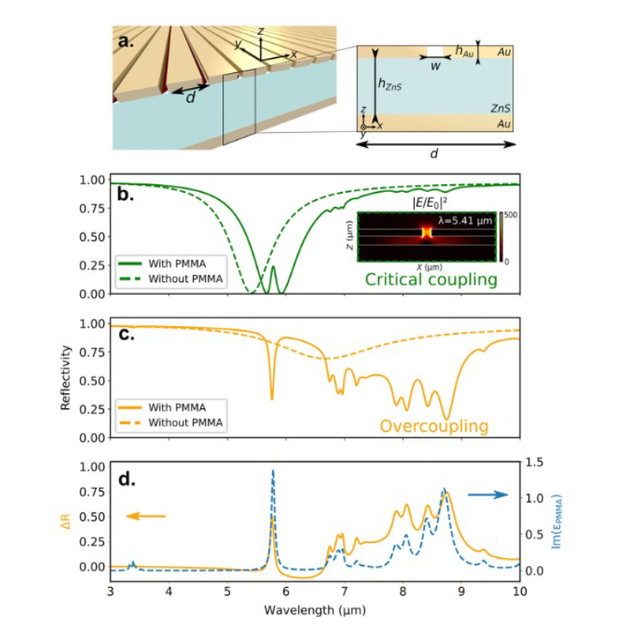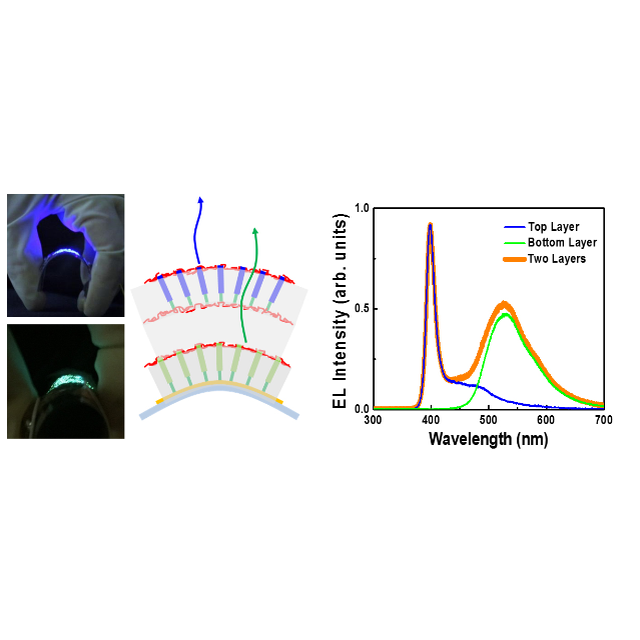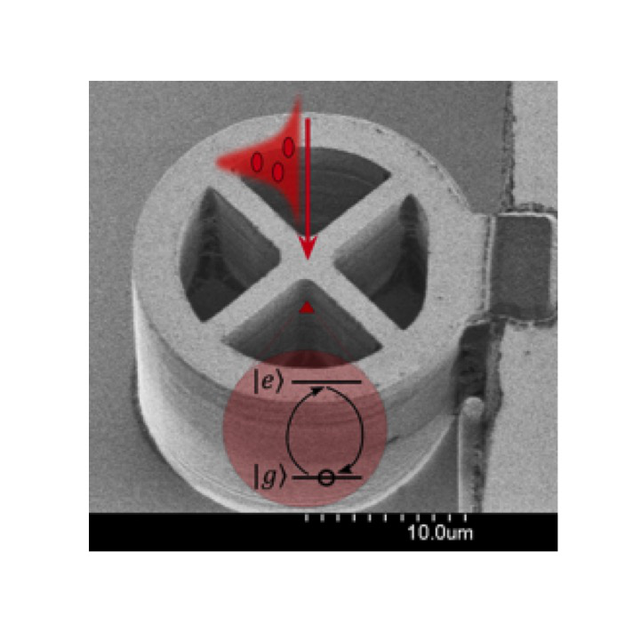Detection of molecules is a key issue for many applications. Surface enhanced infrared absorption (SEIRA) uses arrays of resonant nanoantennas with good quality factors which can be used to locally enhance the illumination of molecules. The technique has proved to be an effective tool to detect small amount of material. However, nanoresonators can detect molecules on a narrow bandwidth so that a set of resonators is necessary to identify a molecule fingerprint. Here, we introduce an alternative paradigm and use low quality factor resonators with large radiative losses (over-coupled resonators). The bandwidth enables to detect all absorption lines between 5 and 10 μm, reproducing the molecular absorption spectrum. Counterintuitively, despite a lower quality factor, the system sensitivity is improved and we report a reflectivity variation as large as one percent per nanometer of molecular layer of PMMA. This paves the way to specific identification of molecules. We illustrate the potential of the technique with the detection of the explosive precursor 2,4-dinitrotoluene (DNT). There is a fair agreement with electromagnetic simulations and we also introduce an analytic model of the SEIRA signal obtained in the over-coupling regime.
In this letter, we introduce an over-coupled resonator that is able to achieve beyond state-of-the-art SEIRA signal on a very broad spectral range while being free of the SPR effect. For the sake of comparison, we first use PMMA, which is a material that has been widely studied for SEIRA demonstrations. We demonstrate experimentally the ability to enhance the absorption of many lines over a broad spectrum from 5 to 10 μm, and report reflectivity differences up to 0.7 for 45 nm thick film and 0.25 for 9 nm thick film which also reproduce the molecular absorption spectrum. The SEIRA signal in the over-coupling regime is analyzed in the framework of the temporal coupled mode theory, and we demonstrate that a given coupling ratio leads to the highest SEIRA signal. We then show that the reflectivity difference can be linked with a linearized model to the amount of absorbing material that is in agreement with experimental measurements. Fig1
The resonator is composed of a dielectric cavity surmounted by a metallic layer, structured with a periodic array of slits where the electric field is highly confined at resonance. We can tune the resonance by changing the geometrical parameters hAu, hZnS, w, and d in order to optimize the coupling with an analyte and obtain the maximum enhancement. We fabricated resonators with sections of the slits of 50 × 45 nm² . The 280 nm thick ZnS layer has been deposited on top of a gold substrate with a 5 nm chromium adhesion layer. The 45 nm gold ribbons were created by electron beam Lithography (EBL) and a lift-off using PMMA resist with a 5 nm chromium adhesion layer. Fig 2
We demonstrate the enhancement potential of the structure by filling entirely the slits with PMMA. To do so, we spin coat A2 PMMA solution on the resonator in order to obtain a 45 nm thick layer. Under TM polarization, we observe a very broad enhancement of the different absorption peaks of the molecule. As expected, the TE response is equivalent to a flat mirror with a thin layer of molecules whose response is very weakly enhanced and undetectable with standard IR spectroscopy.
Finally, we illustrate the ability of the over-coupled regime to identify an absorption fingerprint by applying it to the detection of 2,4-dinitrotoluene (DNT) molecule, a precursor of the explosive molecule trinitrotoluene.
We demonstrate that the same over-coupled resonator geometry is able to enhance the absorption of DNT and PMMA between 5 and 10 μm. The broad and weak resonance of the over coupled structure enables to exploit directly reflectivity difference spectra. Moreover, for thicknesses below 20 nm, we can retrieve quantitative information thanks to a linearized model of the absorption with regards to the quantity of molecules probed. For a majority of the excited vibration modes, the enhancement is also amongst the largest values reported in the state of the art. These slits arrays ensure with a simple fabrication process, large interaction volumes, very good angular tolerance13, and easily tunable resonances that could pave the entire fingerprint region with a limited number of resonators. These are clear advantages for the design and integration of compact and versatile infrared spectroscopy sensors.
Références
Over-coupled resonator for broadband surface enhanced infrared absorption (SEIRA).
Laura Paggi1, Alice Fabas1, Hasnaa El Ouazzani1, Jean-Paul Hugonin2, Nikos Fayard2, Nathalie Bardou3, Christophe Dupuis3, Jean-Jacques Greffet2 & Patrick Bouchon1
Nature Communications 14, 4814 (2023)
DOI : https://doi.org/10.1038/s41467-023-40511-7
Affiliations
1 DOTA, ONERA, Université Paris-Saclay, Palaiseau, France
2 Laboratoire Charles Fabry, Institut d’Optique Graduate School, CNRS, Université Paris-Saclay, Palaiseau, France
3 Centre de Nanosciences et de Nanotechnologies (C2N), CNRS, Université Paris-Saclay, Palaiseau, France
Fig1 : Metasurface for SEIRA of PMMA in the critical coupling and over-coupling configuration
a)Scheme of the resonator array and calculated reflectivity spectra of b) a critically coupled resonator (green lines)with dimensions hAu = 45 nm, hZnS = 50 nm, w = 50 nm and d = 765 nm, and c) an over coupled resonator (orange lines) with dimensions hAu = 45 nm, hZnS = 280 nm, w =50 nm and d) Calculated reflectivity difference ΔR spectrum of the over-coupled resonator (orange continuous line) and imaginary part of the dielectric permittivity of PMMA (blue dashed line)








